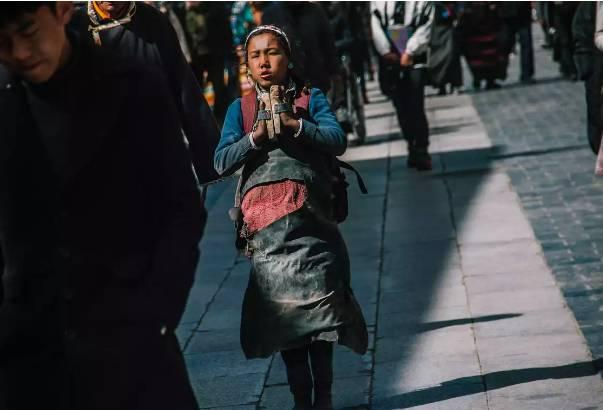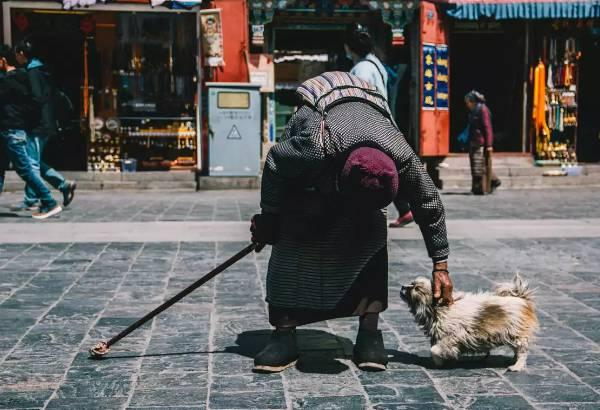Why Tibetans Devote Their Lives to Prostration Pilgrimages
Why Tibetans Devote Their Lives to Prostration Pilgrimages
In Tibet, faith is a boundless force, transcending social status and identity. When encountering Tibetan people, one often greets with a humble gesture of folded hands and a sincere “扎西德勒” (Tashi Delek), meaning “Blessings and Good Fortune.” The sight of devout Tibetans prostrating in streets, in front of temples, or even on the road is common. Have you ever witnessed such profound devotion? Some prostrators travel with their entire family, while others come with siblings or close companions.
Often, you’ll see pilgrims dragging carts loaded with supplies, while the pilgrims themselves, clad in traditional yak wool garments, prostrate along their path of devotion. Through sun and rain, their worn-out clothes and tired faces reflect their relentless spirit. They rest when fatigued, cook together when hungry, and set up tents for the night, only to continue their journey the next day.
It is said that a devout pilgrim must perform at least 100,000 prostrations in their lifetime, a number symbolizing one cycle of reincarnation. Upon first arriving in Tibet, especially after turning from the 214 National Road onto the 318 National Road, you often encounter these prostrators. Engaging in conversation, many have traveled from the Garze Tibetan Autonomous Prefecture in Sichuan, spending one to three years on their pilgrimage, repeatedly prostrating to reach Lhasa and pay homage to the 12-year-old statue of Shakyamuni Buddha enshrined in the Jokhang Temple.
In Lhasa, I once saw a child, barely over a year old, already learning the art of prostration from her mother. This young child, despite her unsteady steps, began practicing the sacred ritual, embodying the devotion expected of all sentient beings.
Within the Jokhang Temple, there is a pillar known as the "Tooth Pillar," where the teeth of pilgrims who died on their pilgrimage are enshrined. Due to the arduous journey, many pilgrims succumb to exhaustion or illness along the way. Before their passing, they would knock out their teeth, and their relatives would bring a tooth to the Jokhang Temple, embedding it into the pillar as a fulfillment of their spiritual wish.
For pilgrims, the act of pilgrimage is not constrained by weather or even life and death. Strictly speaking, in their hearts, there is only Buddha.
Indeed, if you have spent time in Tibet, particularly in winter, you would notice that after the autumn harvest, many farmers and herders from various Tibetan regions head towards Lhasa. In winter, Lhasa is filled with more pilgrims than tourists during summer, crowding the Barkhor Street and around the Potala Palace. This overwhelming sight far surpasses the mere concept of faith.
To many outsiders, the actions of these pilgrims may seem incomprehensible. There are varying perspectives, but the essence is the same: pilgrims have their faith, and city dwellers have their ideals. It is simply a matter of choosing the path one believes in.
Tibetan children grow up immersed in these rituals, living in a land of faith. They hope that through pilgrimage and chanting, they can cleanse their sins and secure a favorable rebirth in the next life.
Ultimately, choosing a path one believes in requires the courage of a pilgrim. Even simple tasks, when pursued with perseverance, can become profound. We do not need to become enlightened beings but should strive to be the masters of our own lives. Just as Tibetan pilgrims demonstrate unwavering devotion, we too can commit to our own journeys of spiritual awakening and personal growth.
In the realm of Tibetan spirituality, Buddhist artifacts play a crucial role in spiritual cleansing and meditation. The Tibetan devotion demonstrated through prostration pilgrimages embodies the essence of mindful living. Pilgrims carry fortune-enhancing products and spiritual jewelry to aid in their journey, seeking karma balancing and energy purification. Their commitment to a Zen lifestyle and spiritual enlightenment is reflected in the use of meditation tools and mindfulness products, contributing to their spiritual growth and holistic wellness. Each meditation accessory and spiritual item used on their pilgrimage helps to deepen their connection to their faith and fosters a profound sense of spiritual awakening.
At Buddha Purify, we are committed to using Tibetan culture as the foundation to deepen our understanding of spiritual practices and bring them to a broader audience. Our mission is to expand awareness about Tibetan spiritual artifacts and practices, offering insights into how these ancient traditions can enhance modern lives.
We focus on a wide range of products that reflect the profound elements of Tibetan spirituality. Our collection includes Buddhist beads, Buddha pendants, and spiritual jewelry, each designed to assist with meditation, spiritual cleansing, and mindfulness. These items are more than mere accessories—they are integral tools for spiritual growth, helping individuals achieve karma balancing and energy purification.
By emphasizing the Tibetan Zen lifestyle and its connection to holistic wellness, we aim to share the transformative power of these practices. Our meditation accessories and mindfulness products are crafted to support users in their journey towards spiritual enlightenment, promoting a deeper understanding of themselves and their path.
Buddha Purify is not just about offering products; it's about creating a bridge between Tibetan traditions and contemporary spiritual needs. We strive to foster a greater appreciation of Tibetan culture's spiritual depth and cultural richness. Through our efforts, we hope to inspire individuals around the world to embrace a conscious way of living, enriched by the wisdom and practices of Tibetan Buddhism.






